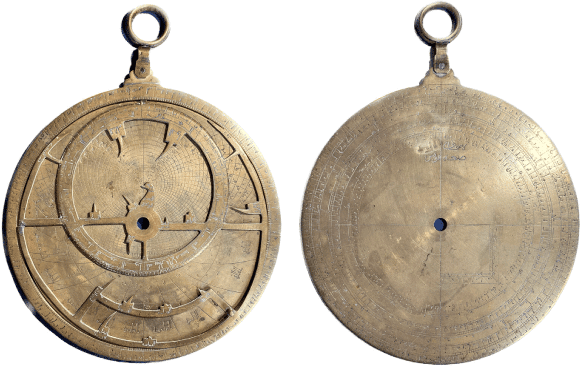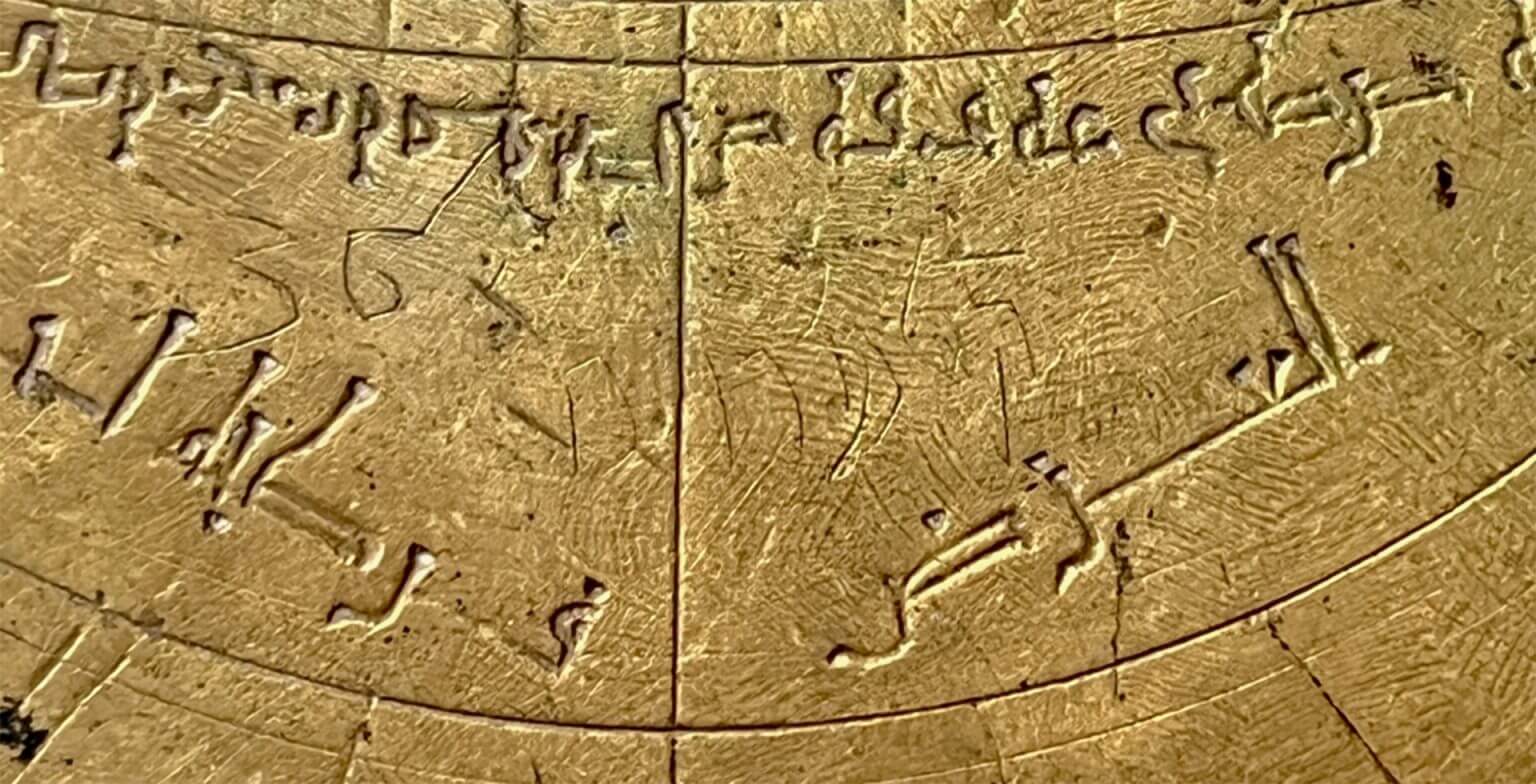A scientist discovered a unique Islamic astrolabe from the eleventh century in Verona, Italy, which includes inscriptions in Arabic and Hebrew. This find illustrates the rich scientific collaboration between Muslim, Jewish and Christian cultures in the Middle Ages, and presents the astrolabe as a symbol of intercultural exchange of knowledge

The discovery of an eleventh-century Islamic astrolabe, inscribed in both Arabic and Hebrew, ranks it among the oldest examples ever discovered and one of the few known in the world. The astronomical instrument was adapted, translated and revised over the centuries by Muslim, Jewish and Christian users in Spain, North Africa and Italy.
Dr. Federica Gigante, from the Faculty of History at the University of Cambridge, discovered the discoveries in a museum in Verona, Italy, and published them in the journal Nuncius.
Dr. Gigante first came across a newly uploaded image of the astrolabe by chance on the website of the Fondazione Museo Miniscalchi-Erizzo. Intrigued, she asked them about it. "The museum didn't know what it was," said Dr. Gigante. "Now it is the most important object in their collection."
"When I visited the museum and studied the astrolabe closely, I noticed that not only was it covered with beautifully engraved Arabic inscriptions, but I could see faint inscriptions in Hebrew. I could only make out them in the raking light coming in from the window. I thought maybe I was dreaming but I kept seeing more and more. It was very exciting."
A close-up of the astrolabe of Verona shows Hebrew written over Arabic

"The astrolabe of Verona underwent many changes, additions and adjustments when it changed hands. At least three different users felt the need to add translations and corrections to this object, two in Hebrew and one in a Western language."
Astrolabes was the world's first "smart phone", a "portable computer" that could be used for hundreds of uses. They provided a portable 2D model of the universe that fits in their user's hand, allowing them to calculate time, distances, chart the position of the stars, and even predict the future, by casting a horoscope.
Islamic Spanish sources
Dr. Giganta, an expert on Islamic astrolabes and a former curator of Islamic scientific instruments, dated and traced the creation of the "Verona Astrolabe" by analyzing key scientific, design, construction and calligraphic features. She identified the object as Andalusian, and based on the style of engraving and the arrangement of the scales on the back, she matched it to vessels made in Al-Andalus, the Muslim region of Spain, in the eleventh century.
One side of a tablet is written in Arabic "for the latitude of Córdoba, 38° 30'", while the other side "for the latitude of Toledo, 40°", لازد تليتلة م. Dr. Gigante suggests that the astrolabe may have been created in Toledo at a time when it was a thriving center of coexistence and cultural exchange between Muslims, Jews and Christians.
The astrolabe includes Muslim prayer lines and prayer names, arranged to ensure that its intended original users keep on time to perform their daily prayers.
A close-up of an astrolabe and a rune showing inscriptions in Hebrew, Arabic and Western letters. Credit: Federica Gigante
The engraved signature on the astrolabe reads / صنعة يونس[…] for Isaac, that is, “because he was cast […] / the work of Yunus”. This inscription was engraved some time after the astrolabe was made probably for a later owner.
The two names, Isḥāq and Yūnus, meaning Isaac and Jonah in Hebrew, could be Jewish names written in the Arabic script, a detail that suggests that the object was circulated at some point within a Sephardic Jewish community in Spain, where Arabic was the spoken language.
Another panel, another, is engraved with typical North African latitudes, suggesting that at another point in the object's life, it may have been used in Morocco, or Egypt.
Inscriptions in Hebrew
Hebrew inscriptions were added to the astrolabe by more than one hand. One set of inserts is deeply and neatly carved, while another set of translations is very light, uneven and shows an uncertain hand.
Dr. Gigante said: "These Hebrew additions and translations indicate that at some point the object left Spain or North Africa and was distributed among the Jewish diaspora community in Italy, where they did not understand Arabic, and instead used Hebrew."
Unusually, one of the Hebrew additions, neatly engraved above the Arabic marking for latitude 35°, reads "34 and a half" and not "34 1/2", suggesting that the engraver was not an astronomer or astrolabe maker.
Other Hebrew inscriptions are instead translations of the Arabic names for astrological signs: Scorpio, Sagittarius, Capricorn, Aquarius, Pisces and Aries.
Dr. Gigante points out that these translations reflect the recommendations of the Jewish-Spanish astrologer Avraham Ibn Ezra (1089-1167) in the earliest surviving treatise on the astrolabe in the Hebrew language, written in 1146 in Verona, exactly where the astrolabe is today.
Jewish Verona
Twelfth-century Verona hosted one of the oldest and most important Jewish communities in Italy. Ibn Ezra's composition assumes knowledge that existed about the astrolabe among the Jewish community in Verona, and shows that the instrument must have already been popular.
Ibn Ezra's description has much in common with the 'Astrola Verona' which was in circulation while Ibn Ezra was in Verona. He warned his readers that a device should be tested before use to verify the accuracy of the values to be calculated.
Dr. Gigante suggests that whoever added the Hebrew inscriptions may have followed such recommendations.
incorrect corrections
The astrolabe includes corrections inscribed not only in Hebrew but also in Arabic numerals, as we use in English today.
On all sides of the astrolabe there are markings lightly scratched in Western numerals, which translate and correct the latitude values, some even several times. Dr. Gigante believes that it is very likely that these additions were made in Verona for a Latin or Italian speaker.
In one case, someone lightly scratched the numbers "42" and "40" next to the inscription "Latitude of Medincheli, 41° 30′".
Dr. Gigante said: "Not only do the two digits differ from the value given in Arabic, they do not agree with each other. A later user of the device may have thought the original Arabic entry was wrong and corrected it. But the correct and modern value for Madincheli's latitude is 41°15′, which indicates that the Arab value was more accurate than the two corrections."
Elsewhere in the instrument, Gigante found similar contradictory and erroneous corrections concerning the latitudes of Cordoba and Toledo.
star map

The astrolabe includes a 'reta' - a perforated disc representing a map of the sky - one of the earliest known maps made in Spain. Remarkably, it shares similarities with the only surviving Byzantine astrolabe made in 1062 AD, as well as with those of the earliest European astrolabes, which were modeled in Spain on Islamic ones.
Calculating the position of the star allows a rough timing of the sky for which it was created. Dr. Gigante explains that "due to a phenomenon called the precession of the equinoxes, in which the Earth rotates on its axis not in a straight line, but in a 'wobbly' way, like a rotating head that is about to stop, the visible position of the stars above our heads is constantly changing, approximately It rises once every 70 years."
By analyzing the position of the stars on Herta, it can be calculated that they were placed where the stars were at the end of the 11th century, and that they correspond to those of other astrolabes created, for example, in 1068 AD.
late life
The astrolabe apparently made its way into the collection of the Veronese nobleman Ludovico Moscardo (1611-81) before joining the Miniscalchi family by marriage. In 1990 the family founded the Fondazione Museo Miniscalchi-Erizzo to preserve the collections.
"This object is Islamic, Jewish and European, it is impossible to separate them," said Dr. Gigante.
More of the topic in Hayadan:

3 תגובות
1- I can understand why Menashe wrote Islamists and not Muslims.
2- The translation of "making Yunus [...] for Isaac" is incorrect, the correct translation is: "the work of Yunus [last name] in Shabal Ishak", the name Yunus is certainly a Muslim Arab, and the name Ishak is not uncommon among Muslim Arabs.
3- The later engravings on the astrolabe are in the range of "Baruch Jamila" at most.
Absolutely no evidence of an exchange of information between Islamists and Jews. Seems like a bit of a drag to write this down.
At that time Jews would write in Arabic, take for example the writings of Rambam, some of them were written in Arabic and translated into Hebrew by Ivan Tibon
No one has proofread this translated news
Sometimes she is a doctor, and sometimes he is a doctor
Male female mistakes, automatic translation that includes mistakes
Too bad